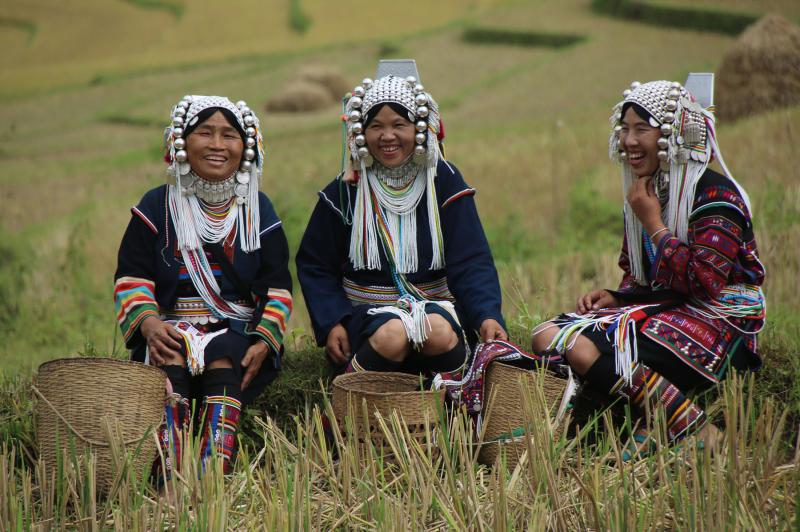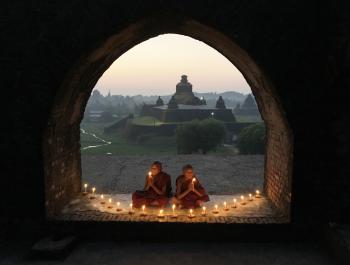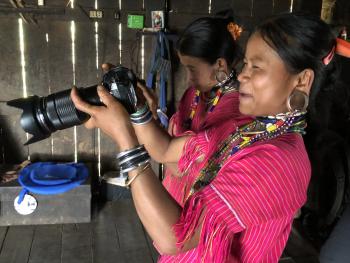An introduction to the tribal cultures of central Myanmar
This article appears on page 20 of the September 2019 issue.
“If I’m an advocate for anything, it’s to move. As far as you can, as much as you can. Across the ocean, or simply across the river. The extent to which you can walk in someone else’s shoes or at least eat their food, it’s a plus for everybody. Open your mind, get up off the couch, move.”
Karl Grobl of Jim Cline Photo Tours (San Diego, CA; 858/353-6210, www.jimclinephototours.com) set the stage early with the above quote from the late Anthony Bourdain as he introduced us to our trip to Myanmar, formerly known as Burma.
In the 5-star setting of the Lotte Hotel in the city of Yangon, where we would spend our first night in Myanmar, Karl prepared us for our travels into remote towns and tribal villages to see people rarely encountered on most tour itineraries.
“You have chosen the tribal trip, not the standard ‘Amazing Myanmar’ (another trip Karl offers in Myanmar)…. We are going to be getting muddy, we are going to be going to places where there is no hotel like this one, we are going to be headed out into parts unknown, and we are going to be experiencing the real Myanmar.”
Introductions
Besides Karl and his local guide/partner MM of Santa Maria Travels & Tours, my wife, Margaret, and I joined a group of six Jim Cline Photo veterans in October 2018 for this 15-day photography tour ($6,975 per person, double, including five domestic flights and four riverboat trips).
We soon learned that we would be exploring central Myanmar, south of Mandalay, from the west coast city of Sittwe, on the Bay of Bengal, to the eastern city of Keng Tung, near the border with China, Laos and Thailand.
The morning after our introductory meeting at the hotel, we were off early, first to visit the Kalaywa Tawya Monastic Education Centre and then to the busy Thiri Mingalar Market.
In this primarily Buddhist country, we soon learned how important it is to respect the cultural “dos” and “don’ts.” Women should be covered when entering pagodas, temples and houses of worship, so wearing shorts, tanktops and other revealing clothing is discouraged.
MM suggested that using some key phrases in the Burmese language, such as “Mingalaba” (MING-GA-LAH-BAH), to say “Hello” or “Goodbye,” and “Kyei zu tin ba de” (JAY-ZOO-TIN-BAH-DAY), or “Thank you,” will be appreciated by locals.
Visiting the locals
Fresh from our first photo ops in Yangon, we were off for a flight to Sittwe, the coastal capital city of Rakhine State. Sittwe was our departure point (by boat) to the temples of Mrauk U, where we spent the day in the company of two young monks-in-training exploring the rich history of Pisi Pagoda and Koe-thaung Temple, ending at sunset at the famous Shaitthaung pagoda.
The following morning we began a 3-hour boat ride up the Lemro River, northeast of Mrauk U, to visit a small village where the tattooed Chin women live.
Along the way, we could see farmers and fishermen at work, and we learned about rice and peanut farming, much in evidence along the route.
MM, who grew up in Myanmar, told us more about the village we were to visit. “There are around five Chin villages on the banks of the southern Laymyro River, and they all belong to the same Lai Tu clan.” We were told there could be as many as a dozen different facial tattoo patterns used by the tribe’s women.
There are many stories about why these women chose to tattoo their faces, and it is difficult to know which is true. One of the most popular says that, in old times, women were taken from their villages and forced to become concubines for the Burmese king. By tattooing their faces, the tribal women sought to make themselves undesirable. Others say the women consider the tattoos a sign of beauty and celebrate them.
After three hours on the river, we walked up a hill to a cluster of simple wooden houses, where a group of five Chin women greeted the women in our group with warm hugs and genuine smiles of welcome.
Sharing cultures
Loikaw was next on our itinerary, from where we would travel by van to visit two different ethnic minorities in the remote villages of Hta Nee La Leh and Pan Pet. In the first village, MM and a local guide took us into a home, where we were serenaded by a husband-and-wife team playing traditional bamboo guitars of their own making.
The special treat of the day, however, was a visit to the Kayan tribe (referred to as Padaung by some).
In his absorbing book, “From the Land of Green Ghosts: A Burmese Odyssey,” a member of the Padaung tribe, Pascal Khoo Thwe, describes why his grandmother, like other Kayan women, chose to encircle her neck with a single coil of an alloy of silver, brass and gold, wrapped 20 or more times.
“In the dark days of anarchy, before the British came, foreign tribes used to raid the villages and carry off our women. To preserve the identity of the tribe, our women ancestors wore rings around their necks so that they could be identified whenever they were reunited with their tribe.”
“These girls start from the age of 5, when the neck is circled only a few times. As they get older, more rings are added.”
Today, Pascal serves as an advisor in the development of all-inclusive tourism in Kayah State. Although some people are critical of tourists visiting the “long-necked” women, saying it is comparable to visiting a zoo, Pascal sees the sharing of his people’s customs, if properly managed, as good for the Kayans and their economy.
Lake Festival
Leaving Loikaw by private coach, we continued to a little town named Hpe Khon, on the western shores of Moe Bye Dam, to rendezvous with the longtail boats that would take us to Inle Lake. The weather was rainy and would remain so for the two days we spent on the lake. However, the Phaung Daw Oo Pagoda Festival the following day would turn out to be a highlight of our journey.
The longtail boats we rode in were slung low to the water but remained remarkably splash-free as we traversed the lake, passing similar boats with visitors and locals. The jackhammer roar of the boat engines filled the air.
The pagoda festival lasts 18 days from October to November each year. As we motored into position to view the procession of boats, a mythical-bird-faced royal barge came into view carrying the four Buddha statues it would take from village to village as part of the celebration.
But what caught my attention most were the boats that towed the barge. Hundreds of celebrants each stood on one leg and used the other to wrap around their multicolored oars, propelling the boats forward.
Keng Tung and beyond
We left Inle Lake the next day for a flight to the town of Keng Tung, the farthest east we would travel, nearing the border with China, Thailand and Laos. On our arrival that afternoon, we were treated to another Buddhist festival, the Thadingyut Festival of Lights, celebrating the full moon. (According to MM, Thadingyut is translated as “the end of Buddhist lent.”)
Our group of photographers split into two teams. One stayed close to our hotel to watch box-shaped lanterns scale the heights of the town center, and I followed MM and two others to the top of a nearby hill, where a crowd of saffron-robed Buddhist novices inflated a 20-foot-high balloon carrying a platform of fireworks that exploded one after the other once it had ascended hundreds of feet in the air.
On the few days that remained before returning to Yangon for our flights back home, we had our last opportunities to explore tribal villages in the Pin Tau area west of Keng Tung.
We visited the black-toothed Eng (Enn) women, the silver-belted women of the Silver Palaung tribe and the Akhi tribal women, who smoked bamboo pipes.
Our final tribal visit was with three women from the Akha tribe as they walked through rice fields and to a waterfall high in a mountain range to the west. All three women were dressed in their best finery for the occasion, wearing multicolored jackets, skirts and leg wraps. Each carried a headdress covered with silver balls, coins, tassels and bird feathers that must have weighed more than 10 pounds.
By the time we returned to Yangon for a final day of exploring, we all agreed that Karl and MM had lived up to their promise of an experience we would long treasure.



